Electrospun Fibrous Materials with Propolis Extracts for Edible Food Packagings
Abstract
1. Introduction
2. Results and Discussion
2.1. Fiber Content Characterization
2.2. Fourier-Transform Infrared Spectroscopy (FTIR-ATR)
2.3. Fibrous Membranes Morphology
2.4. Differential Scanning Calorimetry
2.5. Thermogravimetric Analysis (TGA)
2.6. Microbiology Analysis of Electrospun Membranes
2.7. Tensile Stress-Strain Characteristics
2.8. Air Permeability Analysis of Electrospun Membranes
3. Materials and Methods
3.1. Materials
3.2. Fabrications of Fiber Membranes
3.3. Characterizations of Fiber Membranes and Solutions
4. Conclusions
Author Contributions
Funding
Institutional Review Board Statement
Informed Consent Statement
Data Availability Statement
Acknowledgments
Conflicts of Interest
Sample Availability
References
- Zhao, L.; Duan, G.; Zhang, G.; Yang, H.; He, S.; Jiang, S. Electrospun Functional Materials toward Food Packaging Applications: A Review. Nanomaterials 2020, 10, 150. [Google Scholar] [CrossRef]
- Prakoso, F.A.H.; Indiarto, R.; Utama, G.L. Edible Film Casting Techniques and Materials and Their Utilization for Meat-Based Product Packaging. Polymers 2023, 15, 2800. [Google Scholar] [CrossRef]
- Vidal, C.P.; Muñoz-Shugulí, C.; Vidal, M.P.; Galotto, M.J.; de Dicastillo, C.L. Active Electrospun Mats: A Promising Material for Active Food Packaging. In Electrospinning-Material Technology of the Future; Tański, T., Jarka, P., Eds.; IntechOpen: London, UK, 2022; p. 79949. [Google Scholar] [CrossRef]
- Patiño Vidal, C.; López de Dicastillo, C.; Rodríguez-Mercado, F.; Guarda, A.; Galotto, M.J.; Muñoz-Shugulí, C. Electrospinning and cyclodextrin inclusion complexes: An emerging technological combination for developing novel active food packaging materials. Crit. Rev. Food Sci. Nutr. 2022, 62, 5495–5510. [Google Scholar] [CrossRef] [PubMed]
- Horská, E.; Šedík, P.; Mušinská, K.; Savitskaya, T.; Grinshpan, D.; Kačániová, M. Acceptability of Edible Food Packaging in Slovakia: A Case Study on Young Generation. Front. Sustain. Food Syst. 2021, 5, 720700. [Google Scholar] [CrossRef]
- Reis, M.A.; Sammon, C.; Cabedo, L.; Lagaron, J.M. Preparation and Characterization of Electrospun Food Biopackaging Films of Poly(3-hydroxybutyrate-co-3-hydroxyvalerate) Derived from Fruit Pulp Biowaste. Front. Sustain. Food Syst. 2018, 2, 38. [Google Scholar] [CrossRef]
- Bagher Abiri, A.; Baghaei, H.; Mohammadi Nafchi, A. Preparation and Application of Active Bionanocomposite Films Based on Sago Starch Reinforced with a Combination of TiO2 Nanoparticles and Penganum harmala Extract for Preserving Chicken Fillets. Polymers 2023, 15, 2889. [Google Scholar] [CrossRef] [PubMed]
- Praseptiangga, D.; Joni, I.M.; Tjahjono, B. Editorial: Advances on biopolymers derived from marine and agricultural products for sustainable food packaging applications. Front. Sustain. Food Syst. 2022, 6, 1040144. [Google Scholar] [CrossRef]
- Liu, Y.; Wang, S.; Lan, W.; Qin, W. Development of ultrasound treated polyvinyl alcohol/tea polyphenol composite films and their physicochemical properties. Ultrason. Sonochem. 2019, 51, 386–394. [Google Scholar] [CrossRef] [PubMed]
- Shen, Z.; Rajabi-Abhari, A.; Oh, K.; Yang, G.; Youn, H.J.; Lee, H.L. Improving the Barrier Properties of Packaging Paper by Polyvinyl Alcohol Based Polymer Coating—Effect of the Base Paper and Nanoclay. Polymers 2021, 13, 1334. [Google Scholar] [CrossRef]
- Suganthi, S.; Vignesh, S.; Kalyana Sundar, J.; Raj, V. Fabrication of PVA polymer films with improved antibacterial activity by fine-tuning via organic acids for food packaging applications. Appl. Water Sci. 2020, 10, 100. [Google Scholar] [CrossRef]
- Tang, Y.; Zhou, Y.; Lan, X.; Huang, D.; Luo, T.; Ji, J.; Mafang, Z.; Miao, X.; Wang, H.; Wang, W. Electrospun Gelatin Nanofibers Encapsulated with Peppermint and Chamomile Essential Oils as Potential Edible Packaging. J. Agric. Food Chem. 2019, 67, 2227–2234. [Google Scholar] [CrossRef]
- Gohil, J.M.; Bhattacharya, A.; Ray, P. Studies on the crosslinking of poly (vinyl alcohol). J. Polym. Res. 2006, 13, 161–169. [Google Scholar] [CrossRef]
- Anjum, S.I.; Ullah, A.; Khan, K.A.; Attaullah, M.; Khan, H.; Ali, H.; Bashir, M.A.; Tahir, M.; Ansari, M.J.; Ghramh, H.A.; et al. Composition and functional properties of propolis (bee glue): A review. Saudi J. Biol. Sci. 2019, 26, 1695–1703. [Google Scholar] [CrossRef]
- Devequi-Nunes, D.; Machado, B.A.S.; Barreto, G.D.A.; Rebouças Silva, J.; da Silva, D.F.; da Rocha, J.L.C.; Brandão, H.N.; Borges, V.M.; Umsza-Guez, M.A. Chemical characterization and biological activity of six different extracts of propolis through conventional methods and supercritical extraction. PLoS ONE 2018, 13, e0207676. [Google Scholar] [CrossRef]
- Gutiérrez-Venegas, G.; Gómez-Mora, J.A.; Meraz-Rodríguez, M.A.; Flores-Sánchez, M.A.; Ortiz-Miranda, L.F. Effect of flavonoids on antimicrobial activity of microorganisms present in dental plaque. Heliyon 2019, 5, e03013. [Google Scholar] [CrossRef] [PubMed]
- Tournas, V.H.; Katsoudas, E. Mould and yeast flora in fresh berries, grapes and citrus fruits. Int. J. Food Microbiol. 2005, 105, 11–17. [Google Scholar] [CrossRef]
- Juhnevica, K.; Skudra, G.; Skudra, L. Evaluation of microbiological contamination of apples stored at modified atmosphere. Environ. Exp. Biol. 2011, 9, 53–59. [Google Scholar]
- Abadias, M.; Alegre, I.; Usall, J.; Torres, R.; Viñas, I. Evaluation of alternative sanitizers to chlorine disinfection for reducing foodborne pathogens in fresh-cut apple. Postharvest Biol. Technol. 2011, 59, 289–297. [Google Scholar] [CrossRef]
- Safo, I.A.; Werheid, M.; Dosche, C.; Oezaslan, M. The role of polyvinylpyrrolidone (PVP) as a capping and structure-directing agent in the formation of Pt nanocubes. Nanoscale Adv. 2019, 1, 3095–3106. [Google Scholar] [CrossRef]
- Hashmi, M.; Ullah, S.; Ullah, A.; Saito, Y.; Haider, M.K.; Bie, X.; Wada, K.; Kim, I.S. Carboxymethyl cellulose (Cmc) based electrospun composite nanofiber mats for food packaging. Polymers 2021, 13, 302. [Google Scholar] [CrossRef]
- Zelca, Z.; Kukle, S.; Janceva, S.; Vilcena, L. Propolis Integration Methods into Solutions for Highly Loaded Propolis Fibers by Needleless Electrospinning. Molecules 2022, 27, 2311. [Google Scholar] [CrossRef] [PubMed]
- Svečnjak, L.; Marijanović, Z.; Okińczyc, P.; Marek Kuś, P.; Jerković, I. Mediterranean Propolis from the Adriatic Sea Islands as a Source of Natural Antioxidants: Comprehensive Chemical Biodiversity Determined by GC-MS, FTIR-ATR, UHPLC-DAD-QqTOF-MS, DPPH and FRAP Assay. Antioxidants 2020, 9, 337. [Google Scholar] [CrossRef]
- Svečnjak, L.; Chesson, L.A.; Gallina, A.; Maia, M.; Martinello, M.; Mutinelli, F.; Muz, M.N.; Nunes, F.M.; Saucy, F.; Tipple, B.J.; et al. Standard methods for Apis mellifera beeswax research. J. Apic. Res. 2019, 58, 1–108. [Google Scholar] [CrossRef]
- Akbar, A.; Gul, Z.; Aziz, S.; Bilal, S.M.; Achakzai, J.K.; Saeed, S.; Hlaing Chein, S.; Sher, H. Bio-Functional Potential and Biochemical Properties of Propolis Collected from Different Regions of Balochistan Province of Pakistan. Oxid. Med. Cell. Longev. 2022, 7585406. [Google Scholar] [CrossRef]
- Šutka, A. Technologies, Structure and Properties of Lignocellulosic Nanofibre Bicomponent Filaments. Ph.D. Thesis, Riga Technical University, Riga, Latvia, 2015. [Google Scholar]
- Gaillard, Y.; Mija, A.; Burr, A.; Darque-Ceretti, E.; Felder, E.; Sbirrazzuoli, N. Green material composites from renewable resources: Polymorphic transitions and phase diagram of beeswax/rosin resin. Thermochim. Acta 2011, 521, 90–97. [Google Scholar] [CrossRef]
- Kirty, P.; Mamta, T.; Kumar, C.H.; Nabi, D.B.; Vikas, N. Assessment of fatty acids, amino acids, minerals, and thermal properties of bee propolis from Northern India using a multivariate approach. J. Food Compos. Anal. 2022, 111, 104624. [Google Scholar] [CrossRef]
- ISO 11358-1:2022; Plastics—Thermogravimetry (TG) of Polymers—Part 1: General Principles. ISO: Geneva, Switzerland, 2022.
- ISO 13934-1:2013; Textiles—Tensile Properties of Fabrics—Part 1: Determination of Maximum Force and Elongation at Maximum Force Using the Strip Method. ISO: Geneva, Switzerland, 2013.
- LVS EN ISO 9237:2001; Textiles—Determination of the Permeability of Fabrics to Air. ISO: Geneva, Switzerland, 2001.
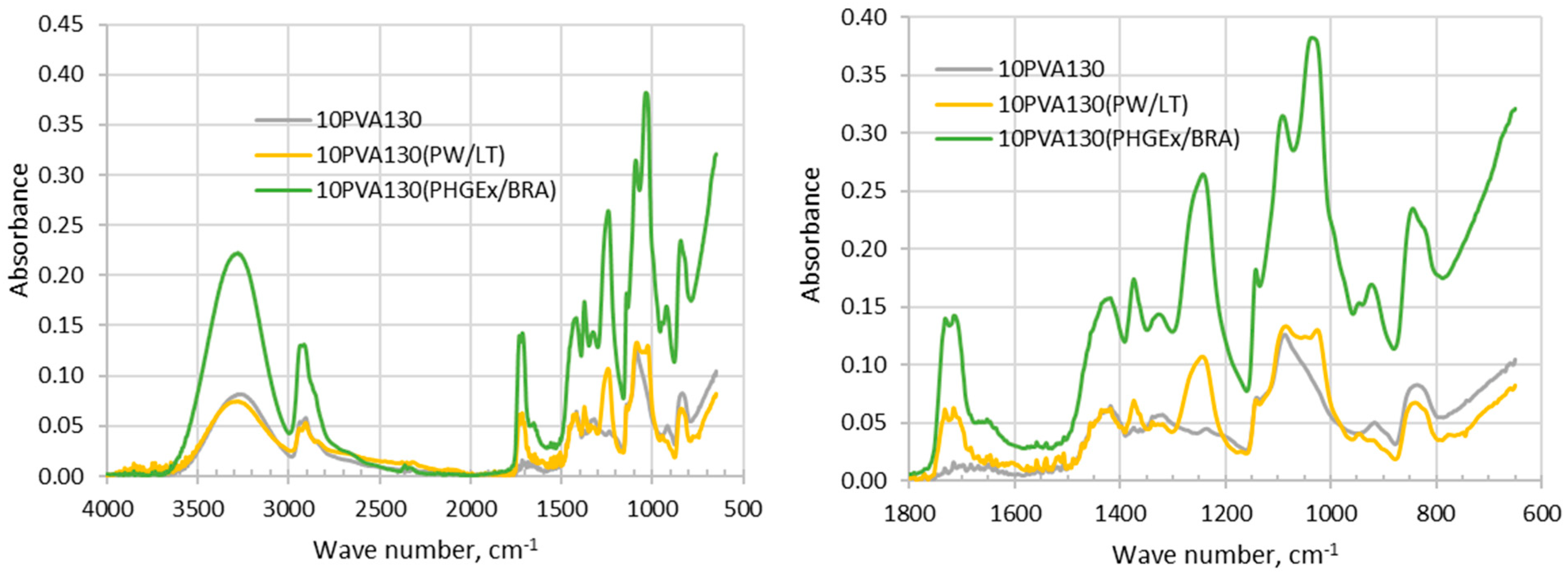
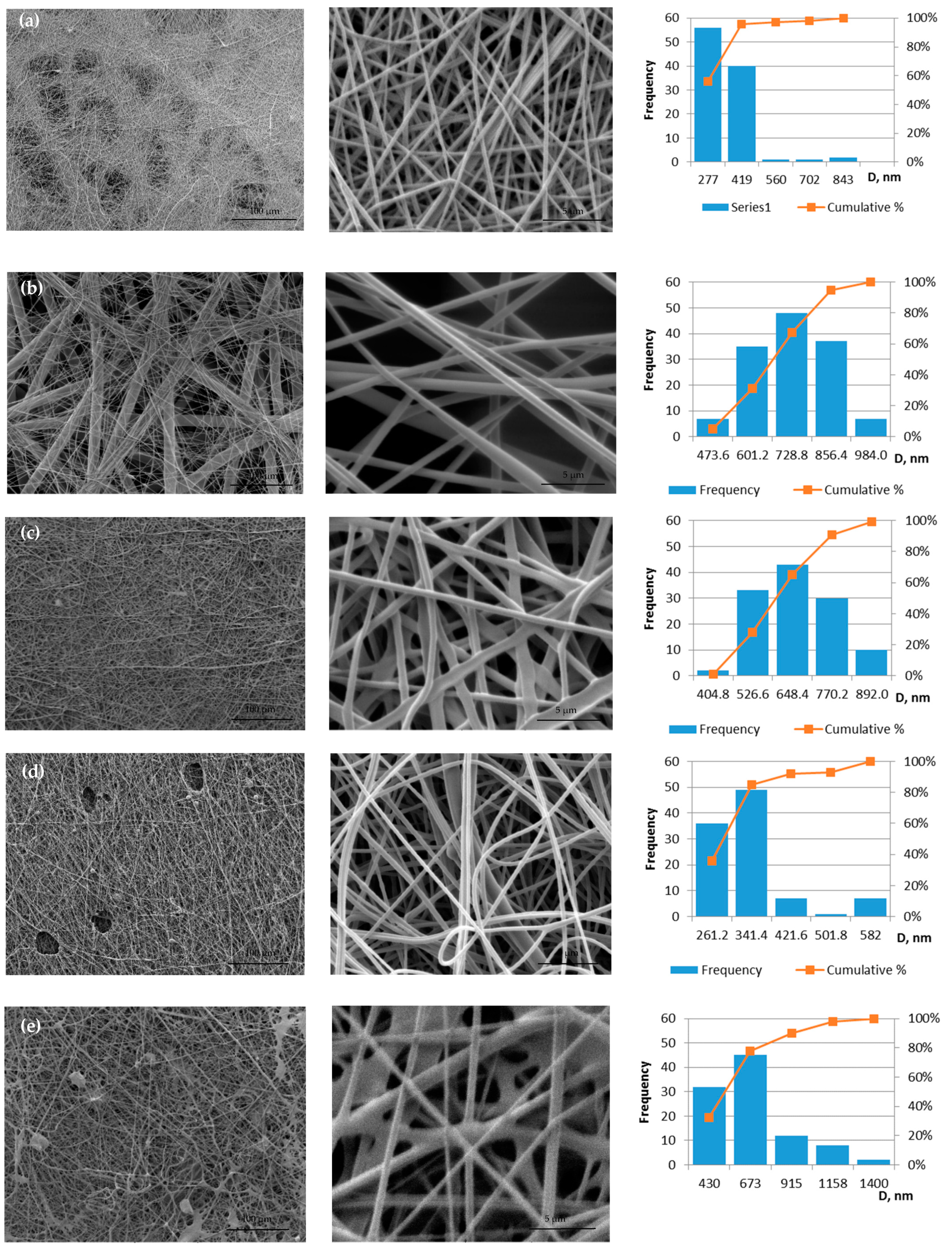


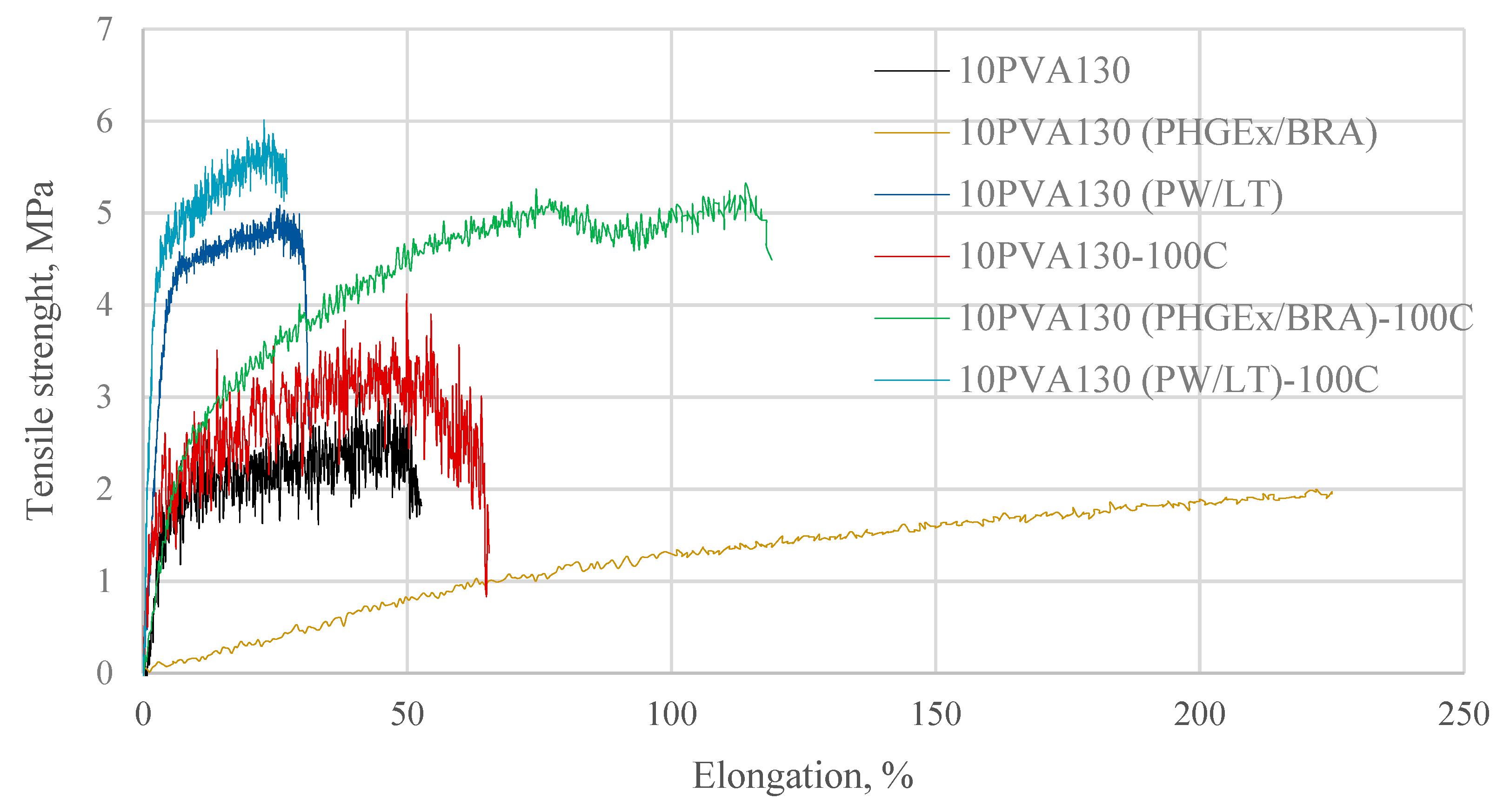
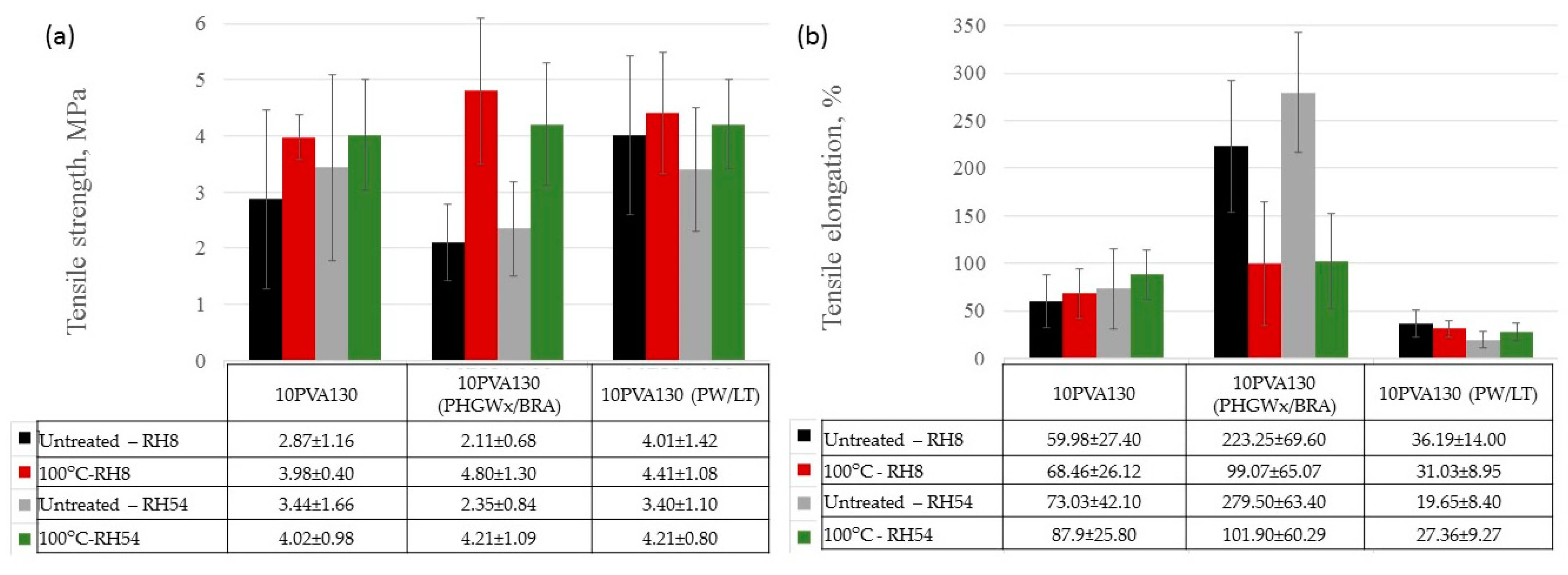
| Fiber Sample | Calculated Propolis Content, % | Total Flavonoids Content mg/g |
|---|---|---|
| 10PVA130(PW/LT) | 73.5 | 4.85 ± 0.11 [22] |
| 10PVA130(PHGEx/BRA) | 12.28 | 5.13 ± 0.21 [22] |
| 10PVA130(PEx/LV) | 29.58 | 74.51 ± 0.42 * |
| Sample | Value of Inhibition Zone (mm) | ||
|---|---|---|---|
| Listeria monocytogenes ATCC 13932 | Salmonella enteritidis ATCC 13076 | Escherichia coli ATCC 25922 | |
| 10PVA130 | 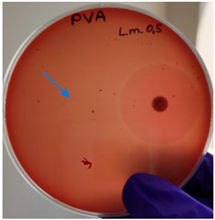 |  |  |
| 10PVA130(PW/LT) | 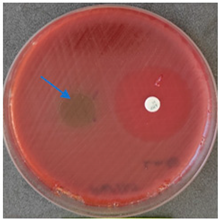 |  | 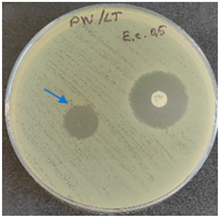 |
| Sample | Air Permeability, L/min | Air permeability Coefficient, mm/s |
|---|---|---|
| 10PVA130 | 0.005 ± 0.0022 | 0.160 |
| 10PVA130(PW/LT) | 0.008 ± 0.0023 | 0.276 |
| 10PVA130(PHGEx/BRA) | 0.001 ± 0.0003 | 0.046 |
| Propolis Extract | PW/LT | PHGEx/BRA | PEx/LV |
|---|---|---|---|
| Manufacturer | UAB Medicata (Vilnius, Lithuania) | B Natural SRL (Corbetta, Italy) | Laboratory-made |
| Propolis content | 30.8% | 20–25% | 30% |
| Propolis origin | Lithuania | Brazil | Latvia |
| Conductivity, µS/cm | 1526 | 3 | 9 |
| pH | 3.6 | 4.5 | 4.9 |
| Total Flavonoids, mg/g | 0.087 ± 0.005 | 1.15 ± 0.08 | 8.87 ± 0.05 |
| Sample | Molar Weight, KDa | PVA Content in Solution, wt% | Mixing Temp., °C | Propolis ex. Content, wt% | Stirring Time, h | Viscosity, mPa∗s | Conductivity, µS/cm | pH |
|---|---|---|---|---|---|---|---|---|
| 10PVA145 | 145 | 10 | 90–110 | 0 | 13 | 782 | 280 | 5.9 |
| 10PVA130 | 130 | 10 | 75–90 | 0 | 2 | 492 [22] | 366 [22] | 5.8 [22] |
| 10PVA130(PW/LT) | 130 | 10 | 75–90 | 90 | 2 | 1004 [22] | 1274 [22] | 4.6 [22] |
| 10PVA130(PHGEx/BRA) | 130 | 10 | 75–90 | 7 | 3 | 276 [22] | 290 [22] | 4.8 [22] |
| 10PVA130(PEx/LV) | 130 | 10 | 75–90 | 14 | 3 | 170 | 160 | 5.6 |
Disclaimer/Publisher’s Note: The statements, opinions and data contained in all publications are solely those of the individual author(s) and contributor(s) and not of MDPI and/or the editor(s). MDPI and/or the editor(s) disclaim responsibility for any injury to people or property resulting from any ideas, methods, instructions or products referred to in the content. |
© 2023 by the authors. Licensee MDPI, Basel, Switzerland. This article is an open access article distributed under the terms and conditions of the Creative Commons Attribution (CC BY) license (https://creativecommons.org/licenses/by/4.0/).
Share and Cite
Zelca, Z.; Merijs-Meri, R.; Krumme, A.; Bernava, A. Electrospun Fibrous Materials with Propolis Extracts for Edible Food Packagings. Molecules 2023, 28, 5497. https://doi.org/10.3390/molecules28145497
Zelca Z, Merijs-Meri R, Krumme A, Bernava A. Electrospun Fibrous Materials with Propolis Extracts for Edible Food Packagings. Molecules. 2023; 28(14):5497. https://doi.org/10.3390/molecules28145497
Chicago/Turabian StyleZelca, Zane, Remo Merijs-Meri, Andres Krumme, and Aina Bernava. 2023. "Electrospun Fibrous Materials with Propolis Extracts for Edible Food Packagings" Molecules 28, no. 14: 5497. https://doi.org/10.3390/molecules28145497
APA StyleZelca, Z., Merijs-Meri, R., Krumme, A., & Bernava, A. (2023). Electrospun Fibrous Materials with Propolis Extracts for Edible Food Packagings. Molecules, 28(14), 5497. https://doi.org/10.3390/molecules28145497






